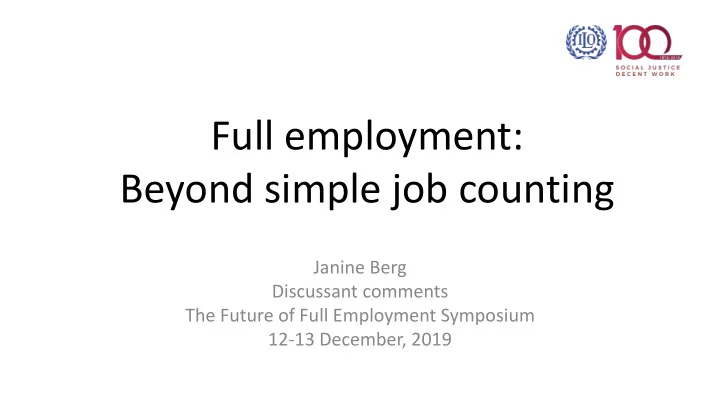

Full employment: Beyond simple job counting Janine Berg Discussant comments The Future of Full Employment Symposium 12-13 December, 2019
• An incomplete story is being told – Need to move beyond the U rate – But also beyond underemeployment – importance of tracking working conditions • Why aren’t we creating enough good jobs? – Job creation (macro/industrial policy) – Job quality (institutional)
Tracking working conditions 7 dimensions of job quality ILO/Eurofound joint report, 2019
Working time quality Flexible working arrangements How easy is it to arrange to take an hour off during working hours to take care of personal or family Atypical working hours matters? – 10 to 20 % work night shifts - Between 36% (Turkey) and over 70% (Korea) – Similar proportions work shifts – Around 50% work week ends (at least Work in ‘free time’ once a month) Around 30% in Europe, Turkey and Korea at least several times a month. Working time arrangement Very frequently reported in the US ( slightly – For the majority of workers in Korea, different wording) EU28 and China, hours are set by their company with no possibility for change – Around 10% can choose between Just-in-time scheduling different schedules offered by their – 10 to 15% report that they are informed of company changes in their working time arrangements – Wide country differences on possibility either on the same day or the day before to adapt one’s working hours
Good jobs aren’t created in a vacuum Macro policy Industrial (monetary, policy fiscal, credit) Public Decent investment in jobs infrastructure Social (physical and protection social) Labour market institutions
Insufficient job creation: A bias in monetary over fiscal policy, yet private investment not being «crowded in» Source: UNCTAD, 2019.
Most jobs are pretty ordinary Predicted growth of STEM jobs Top 10 occupations in the US 2018 6.4% Retail Salespersons 4,448,120 Food prep and serving, incl. fast food 3,676,180 Cashiers 3,635,550 Office Clerks, General 2,972,930 STEM occupations Non-STEM occupations Registered Nurses 2,951,960 Laborers and Freight, Stock, and 2,893,180 Material Movers, Hand 2028 6.7% Customer Service Representatives 2,871,400 Waiters and Waitresses 2,582,410 General and Operations Managers 2,289,770 Personal Care Aides 2,211,950 - 2,000,000 4,000,000 STEM occupations Non-STEM occupations Source: US Bureau of Labour Statistics.
But just because it is not high skilled, doesn’t mean working conditions should be poor Retail Job Characteristics across Six Industrialized Countries, mid-2000s Percentage that Annual labour Part-time Value-added per hour are low-wage turnover (%) worked, 2005 euros, workers (%) (<2/3 median) PPP Denmark 23 36 50 21.94 France 18 20 28 29.55 Germany 42 20 47 26.36 Netherlands 46 27 70 23.43 United Kingdom 49 26 51 24.59 United States 42 50 28 25.41 --Plus differences in leave/rest policies, scheduling, whether they can sit…
Part-time work can be of high quality, if policy design supports it
Z. Ton (2014), The Good Jobs Strategy Finds that increasing payroll costs results in higher profit margins. At Spanish retailer, Mercadona: • all of its 74,000 employees were on permanent contracts in 2012. • Employee turnover was a mere 3.4 percent. • And sales per square foot were 50% higher than Carrefour, with sales per employee increasing from €109, 474 in 1995 to €257,797 in 2012.
Book includes a great quote from Keynes: (p. 79): Referring to depression of 1930s, «For I believe, that our destiny is in our own hands and that we can emerge from it if only we choose — or rather if those choose who are in authority in the world»
Thank you!
Recommend
More recommend